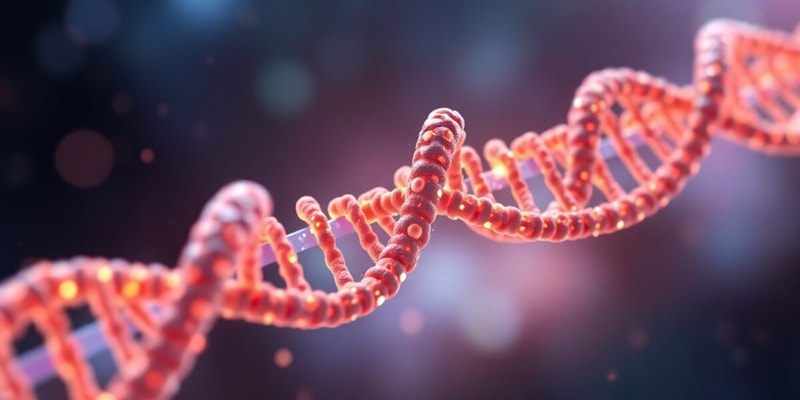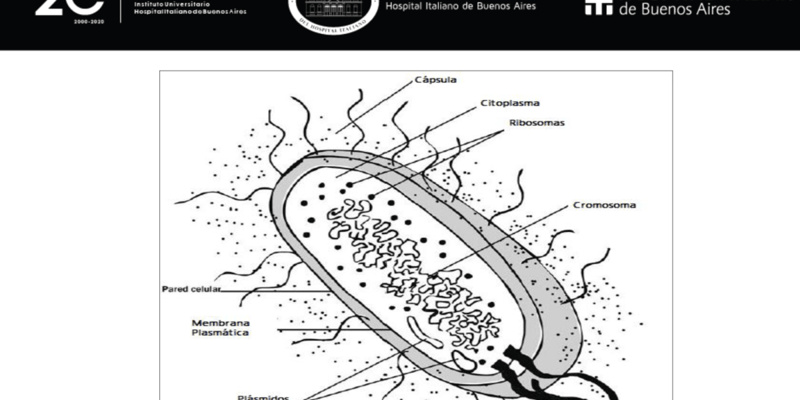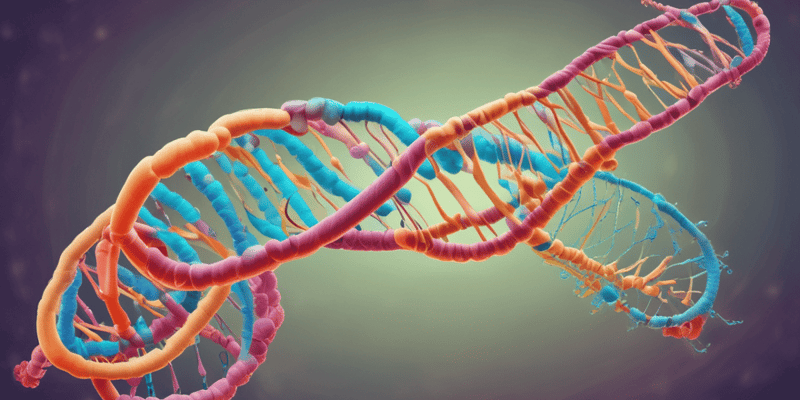Podcast
Questions and Answers
What distinguishes somatic mutations from germ-line mutations?
What distinguishes somatic mutations from germ-line mutations?
Which of the following best defines epigenetics?
Which of the following best defines epigenetics?
Which of the following statements about DNA methylation is true?
Which of the following statements about DNA methylation is true?
What characteristic best describes a heterozygous genotype?
What characteristic best describes a heterozygous genotype?
Signup and view all the answers
Which of the following is a key characteristic of non-coding RNAs?
Which of the following is a key characteristic of non-coding RNAs?
Signup and view all the answers
What is the primary result of hypermethylation of CpG islands in DNA?
What is the primary result of hypermethylation of CpG islands in DNA?
Signup and view all the answers
Which best describes the inheritance pattern influenced by multiple genes and environmental factors?
Which best describes the inheritance pattern influenced by multiple genes and environmental factors?
Signup and view all the answers
Which of the following describes a characteristic of somatic mutations?
Which of the following describes a characteristic of somatic mutations?
Signup and view all the answers
Which of the following is a feature of epigenetic modifications?
Which of the following is a feature of epigenetic modifications?
Signup and view all the answers
What does a heterozygous genotype consist of?
What does a heterozygous genotype consist of?
Signup and view all the answers
Study Notes
Structure of the Chromosome
- Chromosomes are made up of DNA and proteins.
- DNA is a double helix, with the two strands held together by hydrogen bonds.
- Genes are sections of DNA that code for proteins.
- Each chromosome contains a single, very long molecule of DNA.
- Each chromosome is unique, with its own set of genes.
Transcription
- DNA is transcribed into RNA.
- This process occurs in the nucleus of the cell.
- The RNA molecule is then transported to the cytoplasm, where it is translated into protein.
Translation
- The RNA molecule is translated into protein.
- This process occurs in the ribosomes of the cell.
- The ribosomes read the RNA molecule and assemble the amino acids into a protein.
Genetic Code
- The genetic code is the set of rules by which information encoded in genetic material (DNA or RNA sequences) is translated into proteins (amino acid sequences).
- Each codon (set of 3 nucleotides) codes for a specific amino acid.
- There is a start codon and a stop codon, that signal the beginning and end of the protein translation process.
Patterns of Inheritance
- A trait can be determined by one set of alleles or a specific gene and two alleles (Mendelian inheritance).
- Traits can be influenced by more than one gene (non-Mendelian inheritance)
- Traits can show continuous variation.
- Traits can be influenced by environmental factors.
Mutations
- A germline mutation is passed through gametes to the next generation, affecting every cell.
- A somatic mutation occurs in a particular cell and cannot be passed on.
- Mutations can be small, such as single nucleotide changes.
- Mutations can also be large, such as deletions or insertions of DNA.
- Mutations can change the amino acid sequence of a protein, potentially impacting its function.
Epigenetics
- Explains heritable traits not explained by genetic sequence.
- Conveyed through modifications of DNA structure.
- Chemical modifications of DNA and proteins.
- Reversible.
- No change to DNA sequence.
DNA Methylation
- The addition of a methyl group to a cytosine base in DNA.
- Hypermethylation of CpG islands inhibits transcription.
- Hypomethylation activates transcription.
Histone Modification
- Histones are positively charged nuclear proteins.
- Histone modifications can alter the accessibility of DNA to transcription factors.
- These modifications can be associated with gene activation or repression.
Non-coding RNA
- A group of RNAs that don’t encode functional proteins.
- Examples include:
- microRNAs (miRNAs)
- long non-coding RNAs (lncRNAs)
- small interfering RNAs (siRNAs)
- These RNAs are involved in a variety of cellular processes, including gene regulation, development, and disease.
Terminology
- Genotype: The genetic makeup of an individual.
- Phenotype: The observable characteristics of an individual.
- Alleles: Alternative forms of the same gene found at the same place on a chromosome.
- Homozygous: Having two of the same alleles.
- Heterozygous: Having two different alleles.
Chromosome Structure
- A chromosome is a long strand of DNA containing genes
- Each gene has its own locus (position) on the chromosome
- Humans have 23 pairs of chromosomes, with one chromosome from each pair inherited from each parent
Transcription and Translation
- Transcription is the process of copying DNA into mRNA
- Translation is the process of using mRNA to create proteins
Genetic Code
- The genetic code dictates which amino acids are coded for by each codon (3 base pairs of DNA)
- Codons are read sequentially to synthesize a protein
Genetic Inheritance
- Mendelian inheritance refers to traits determined by a single gene with two alleles
- Non-Mendelian inheritance is governed by more than one gene and can lead to continuous variation
- Polygenic inheritance involves traits influenced by multiple genes and environmental factors
Mutations
- Germ-line mutations are passed on through gametes and affect every cell in an individual's body
- Somatic mutations occur in a single cell and are not passed on to offspring
- Point mutations involve a single base pair change in DNA, potentially leading to missense (altered amino acid), nonsense (stop codon), or silent (no change in amino acid) mutations
Larger Mutations
- Insertions involve adding extra DNA into a sequence
- Deletions involve removing segments of DNA
Epigenetics
- Epigenetics explains heritable traits that are not accounted for by the underlying DNA sequence
- These traits are conveyed through modifications to the structure of DNA
- These modifications can be influenced by environmental factors, are reversible, and do not change the DNA sequence
DNA Methylation
- DNA methylation is a process that adds a methyl group to a cytosine base
- Hypermethylation of CpG islands can inhibit transcription while hypomethylation can activate it
Histone Modification
- Histones are positively charged proteins that package and organize DNA in the nucleus
- Histone modifications, like acetylation, can alter the accessibility of DNA for transcription, and influence gene expression
Non-Coding RNA
- Non-coding RNA does not encode proteins and can have regulatory roles in gene expression
- Examples of non-coding RNA include:
- MicroRNA (miRNA) which can silence genes by binding to mRNA
- Long non-coding RNA (lncRNA) which can regulate gene expression by interacting with DNA, RNA, and proteins
- Small interfering RNA (siRNA) which can degrade mRNA
Terms
- Genotype refers to the genetic makeup of an individual, e.g., HH or Hh
- Phenotype is the observable trait, e.g., the physical manifestation of a genotype
- Alleles are alternative forms of the same gene found at the same locus on a chromosome
- Homozygous means having two identical alleles for a gene -Heterozygous means having two different alleles for a gene
Studying That Suits You
Use AI to generate personalized quizzes and flashcards to suit your learning preferences.
Related Documents
Description
This quiz covers the essential aspects of chromosomes, focusing on their structure, transcription, translation, and the genetic code. Explore how DNA is organized within chromosomes and how genetic information is expressed through RNA and proteins.



